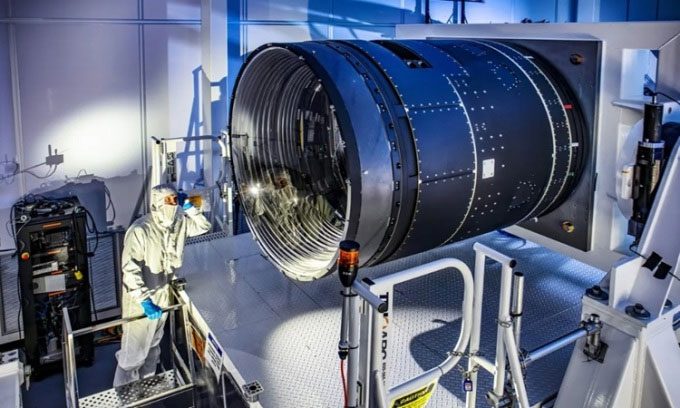With the LSST 3.2 Gigapixel Camera, the Vera C. Rubin Observatory Can Uncover Secrets of Dark Matter and Dark Energy.
The Vera C. Rubin Observatory is set to initiate the Legacy Survey of Space and Time (LSST), which will monitor the entire southern hemisphere sky thousands of times. This monumental mission requires an equally grand camera. The SLAC National Accelerator Laboratory is responsible for providing such equipment. Scientists and engineers at SLAC have completed the LSST camera, the largest digital camera in the world designed for a groundbreaking 10-year survey, as reported by Space on April 3.

The LSST camera is complete and ready for transport to the Vera C. Rubin Observatory. (Photo: SLAC).
The LSST camera, with a resolution of 3.2 gigapixels, is the size of a small car and weighs 3 tons, equivalent to half the weight of an adult African elephant. Its wide-field observation capability will aid in uncovering many mysteries surrounding dark energy, which constitutes about 70% of the universe’s energy density and accelerates cosmic expansion. The LSST will also investigate dark matter, which makes up 85% of the universe’s matter but is not visible to the naked eye, and will answer many other astronomical questions, according to Željko Ivezić, the director responsible for constructing the Vera C. Rubin Observatory.
Aaron Roodman, a professor at SLAC and deputy director of the Vera C. Rubin Observatory in charge of the camera program, stated that the LSST survey will enable the observation of billions of galaxies, an estimated 17 billion stars in the Milky Way, and billions of objects within the Solar System. Images captured by the LSST camera are detailed enough to clearly see a golf ball from a distance of 24 kilometers, and it can observe an area of the sky seven times larger than a full moon.
One of the main advantages of the LSST survey is its ability to repeatedly observe the same region of the sky multiple times. This will allow scientists to accurately track any changes occurring in that area over the course of 10 years. They will witness transient events such as the brightening and fading of supernova explosions, light curves emitted from distant sources caused by the gravitational pull of moving matter, and monitor the expansion of space, pushing many distant galaxies further away. These galaxies will drift away increasingly rapidly under the influence of dark energy.
Before the LSST camera can assist researchers in understanding dark energy and other cosmic mysteries, it must be transported from the SLAC facility in Menlo Park, California, to the summit of Cerro Pachón, which stands at 2,713 meters in the Andes Mountains of Chile. Once there, the camera will be installed atop the Simonyi Survey Telescope later this year.
Not only does the size of the LSST camera make transportation extremely challenging, but the camera is also particularly fragile, with its focal plane consisting of 201 custom-designed CCD sensors. These sensors are only 5 microns thick, with a thickness variation of no more than 1/10 the width of a human hair. In comparison, a standard sheet of paper is 50 to 100 microns thick.
The spacing between the sensors is about half a millimeter, which means preventing them from colliding with each other is a significant challenge during production and transport. The research team has tested the transport route for the LSST camera using a mock object of the same weight and shape as the camera. They also attached an accelerometer to this mock object to assess the stress placed on the camera during the flight to Chile. Once the LSST is positioned, the equipment will be installed and operational. The first images from the LSST will be released in the spring of next year.


















































